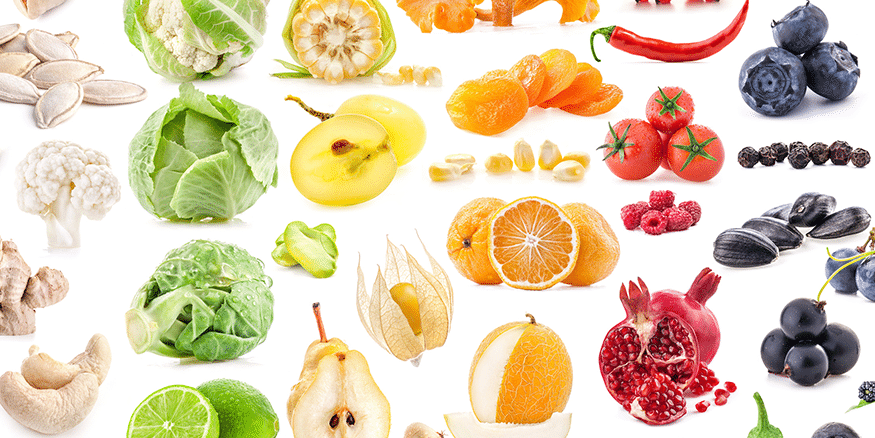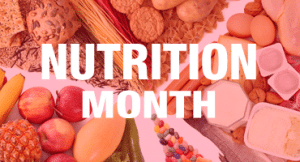
Colourful Nutrition
Life would be boring if we saw the same bland, colourless foods on our plates every day. Nature remedies this by providing us with a variety of beautifully coloured vegetables and fruits to excite our eyes and stimulate our taste buds.
We may not be aware of it, but the colour of an object influences our choice in everything from the food we eat to the clothes we wear. There are many theories to explain where our colour preferences come from. The Ecological Valence Theory suggests that colour preference is adaptive; the more positive, experience-based feedback a person receives about a particular colour, the more likely that person is to choose it again. California researchers asked 48 participants to rate their preference of 32 different colours. Bright, vibrant colours were preferred over the same colours in lighter or muted hues. The most highly favoured colours were red, blue, and green.1
Brightly pigmented foods are loaded with vitamins, minerals, fibre, and water, which help to keep us living and thriving. Vegetables and fruits are also rich in phytochemicals (also known as phytonutrients). These naturally occurring compounds play an important role in health promotion and disease prevention. There is a vast range of phytochemicals found in the foods we eat (over 5,000 have been identified!) including alpha and beta-carotene, anthocyanins, lycopene, lutein, and flavonoids.2 Phytochemicals contribute to the colour, flavour, and aroma of our food. Different coloured vegetables and fruits contain different phytochemicals, which is why it is so important to eat a colourful diet to get all the wide-ranging benefits.
Red
Many red-hued foods, such as tomatoes, watermelon, pink grapefruit, and papaya, get their colour from lycopene, a red carotenoid pigment and phytochemical. As an antioxidant, lycopene helps protect the cellular systems of the body from oxidative damage and lower the risk of chronic diseases.
Lycopene is the active component in tomatoes believed to be responsible for the decreased risk of certain cancers, including prostate, ovarian, pancreatic, bladder, breast, and stomach, associated with consuming this fruit.3 This important phytochemical goes to work in the body to inhibit the proliferation of cancerous cells, neutralize reactive oxygen species, modify cell-to-cell communication, and enhance the body’s own immune system.
In 2013, Chinese researchers published a meta-analysis of 17 studies related to the risk of gastric cancer that investigated tomatoes, tomato products, and lycopene. Their findings showed that an increase in tomato product consumption was associated with a 36% reduced risk of stomach cancer.3
Interestingly, cooking greatly increases the amount of lycopene we absorb by breaking down the plant cell wall. This means that tomato-based pasta sauces and soups are much higher in lycopene than raw tomatoes.
Sources: beet, cranberries, guava, papaya, pink grapefruit, pomegranate, radishes, raspberries, red cabbage, red grapes, rhubarb, tomato, and watermelon.
Orange and Yellow
Beta-carotene (b-carotene) is responsible for the orange and yellow colour of many vegetables and fruits. Green-coloured produce also contains b-carotene, but the green chlorophyll pigment masks the orange colour. B-carotene converts to vitamin A in the body, which helps keep eyes, skin, bones, and teeth healthy. Like the other phytochemicals, it may reduce the risk of cancer and heart disease, and help boost immune function.4 Eating too much b-carotene (e.g., carrots) might make your skin turn yellow due to a rise of b-carotene levels in the blood. This is not harmful, but it probably isn’t the summer glow you were going for!
The lesser-known alpha-carotene is in the orange, yellow, and red colour food groups. In a large prospective study of 15,318 US adults, researchers found that a high blood level of alpha-carotene was associated with a lower risk of death from cancers of the aerodigestive tract.5 The aerodigestive tract includes the organs and tissues of the respiratory tract and the upper GI tract such as the mouth and esophagus.
Aside from alpha- and beta-carotene, this colour group also contains lutein and flavonoids. Lutein is a phytochemical that protects against loss of vision (macular degeneration) and promotes eye health, whereas flavonoids act as antioxidants and protect against cancer-causing substances (carcinogens).4
Sources: apricot, butternut squash, carrot, cantaloupe, corn, lemon, mango, papaya, peach, persimmon, pineapple, pumpkin, sweet potato, tangerine, winter squash, yellow tomato, and yellow watermelon.
Green
Darker is better when it comes to choosing your greens. Dark green leafy vegetables are higher in carotenoids than are their paler counterparts, which is why romaine and spinach varieties are better choices than iceberg lettuce.6 They’re also high in lutein, the phytochemical that promotes eye health, as discussed above.
Spinach is a great source of both b-carotene and lutein. Studies have also suggested it functions as an inhibitor of the growth and spread of cancer cells and has the ability to reduce age-related eyesight deterioration.7
Greens are also abundant in vitamin K, which helps blood clot properly and the mineralization of bones to keep them healthy and strong. Green foods are also a rich source of vitamin C, vitamin E, and other antioxidants, like the rest of the vegetable/fruit group, which may reduce the risk of chronic disease.2
Did you know that avocadoes are actually a fruit containing 60% more potassium than bananas?8 They also provide a healthy dose of monounsaturated fat that, when eaten in moderation, can lower cholesterol. If you are looking to impress your dinner guests, consider serving the fun and mini avocadoes (avocaditos) at your next party.
Sources: artichoke, asparagus, avocado, broccoli, Brussels sprouts, cucumber, green beans, green bell pepper, green grapes, honeydew melon, kale, kiwi, lime, spinach, and other leafy greens.
Blue and Purple
Anthocyanins are the antioxidants responsible for the blue and purple spectrum of the vegetable and fruit world. This colour group contains ellagic acid and other flavonoids, which may help destroy cancer cells and also provide anti-inflammatory properties that could further help protect against chronic diseases.9
A small human trial investigating the therapeutic potential of bilberries, also referred to as “European blueberries”, in patients with ulcerative colitis (UC) showed promising results. Participants who had mild to moderate UC consumed a daily bilberry oral preparation for a total of six weeks. At the end of the study period, there were high rates of clinical remission in participants with reductions in mucosal inflammation observed. However, the study investigators stressed that these results would likely not translate if UC patients simply increased their intake of whole berries since they used a concentrated extract in the trial.10
There is also promise for the use of figs, blackberries, and grapes as antioxidant and anti-cancer therapeutic agents, but health care professionals require additional high-quality human studies in this area before they can make any recommendations.11,12,13,14
Blueberries own the bragging rights for having almost four times the amount of cancer-fighting and inflammation-reducing antioxidants than most fruits. Wild blueberries have the highest levels, which is double that of regular blueberries. Interestingly, Nova Scotia is the largest producer of wild blueberries and recognizes it as their official provincial berry.15
Sources: blueberries, blackberries, eggplant, fig, juneberries (Saskatoon berries), plum, prune, purple grapes, and dark raisins.
White
Despite their neutral colour, white vegetables and fruits contain many phytochemicals. In garlic alone, there are at least 100 bioactive compounds with antioxidant, antithrombotic, antitumor, anti-inflammatory, and antihypertensive components.16
Cauliflower and other cruciferous vegetables, including cabbage, bok choi, Brussels sprouts, and broccoli, are rich in fibre and cancer-fighting phytochemicals such as sulforaphane, a compound that protects the lining of the stomach by preventing bacterial overgrowth of Helicobacter pylori.17
A recent study evaluated the association of cruciferous vegetable intake and circulating levels of pro-inflammatory markers in 1,005 middle aged Chinese women. Researchers assessed their usual dietary intake over the preceding twelve months using a comprehensive food frequency questionnaire and measured their blood and urine for inflammation and oxidative stress markers. After adjusting for potential confounding variables, including socioeconomic status, lifestyle factors, BMI, health conditions, and medication use, the researchers found that a higher intake of cruciferous vegetables was associated with significantly lower circulating concentrations of the pro-inflammatory markers.18 Chronic inflammation, also known as low-grade inflammation, can play a role in ailments such as celiac disease, inflammatory bowel disease, and rheumatoid arthritis.
White vegetables and fruits have also shown promise when it comes to preventing strokes. Interestingly, a study of approximately 20,000 men and women found that a high intake of white vegetables and fruits was associated with a 52% lower risk of stroke.19 That’s quite a reduction!
Is cauliflower really the new kale? Growing in popularity, you can now find purple and orange varieties of cauliflower. The purple colour is due to the presence of anthocyanins. Watch as the purple cauliflower transforms to green while being cooked!
Sources: apple, banana, cabbage, cauliflower, cucumber, garlic, ginger, jicama, mushrooms, onion, parsnip, pear, potato, and turnip.
Conclusion
Delicious fruits and vegetables provide us with essential nutrients and give us a big dose of phytochemicals. Research continues to reveal the health benefits of incorporating plant-based foods into our daily diet. It is likely the combination and synergy of antioxidants, vitamins, minerals, and fibre found in whole foods that are responsible for the positive impact they have on our overall health. For these reasons, it is important to eat a wide variety of vegetables and fruits on a regular basis. Please treat yourself and take advantage of what grows naturally, so you can get all the nutrients you need.
Want to learn more about nutrition?
Read the articles on our nutrition month page.

